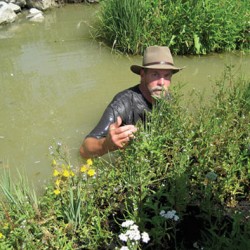Mammoth Island
By ten thousand years ago, woolly mammoths had gone extinct from mainland Asia and North America. But a population of island-dwelling mammoths survived on a remnant piece of land once part of the Bering Strait land bridge.
UW geography professor Jack Williams and graduate student Yue Wang MS’13 contributed to a new study that provides clear evidence of the mammoth extinction on tiny St. Paul Island around 5,600 years ago. A lack of freshwater and changing environmental conditions, including rising seas, drove the demise. The researchers say the findings have implications for low-lying islands, and the people and animals that live on them today.
“I can’t think of any other case where freshwater availability was the driver of extinction,” says Williams, who is also director of the UW’s Center for Climatic Research. “On small oceanic islands, freshwater can be a limited resource.”
Williams and collaborators from across the United States rode snowmobiles to one of the few sources of freshwater on the island off the coast of Alaska, a crater lake surrounded on three sides by steep rock walls. The scientists drilled through the frozen lake surface and took samples of sediments beneath the lake floor, which provided snapshots of the environment through time.
The UW researchers focused on the island’s vegetation and ruled out changes to their food sources as contributors to the mammoths’ extinction. However, sediment cores showed mammoths likely stripped the area around the lake of vegetation, potentially speeding up erosion and harming water quality.
Published in the Winter 2016 issue




Comments
No comments posted yet.